ISSN ONLINE(2278-8875) PRINT (2320-3765)
ISSN ONLINE(2278-8875) PRINT (2320-3765)
Sukhmeet Kaur1, Suman2, Manpreet Singh Manna3, Rajeev Agarwal4
|
| Related article at Pubmed, Scholar Google |
Visit for more related articles at International Journal of Advanced Research in Electrical, Electronics and Instrumentation Engineering
Binary division is basically a procedure to determine how many times the divisor D divides the dividend B thus resulting in the quotient Q. At each step in the process the divisor D either divides B into a group of bits or it does not. The divisor divides a group of bits when the divisor has a value less than or equal to the value of those bits. Therefore, the quotient is either 1 or 0. The division algorithm performs either an addition or subtraction based on the signs of the divisor and the partial remainder. There are number of binary division algorithm like Digit Recurrence Algorithm restoring, non-restoring and SRT Division (Sweeney, Robertson, and Tocher), Multiplicative Algorithm, Approximation Algorithms, CORDIC Algorithm and Continued Product Algorithm. This paper focus on the digit recurrence non restoring division algorithm, Non restoring division algorithm is designed using high speed subtractor and adder. High speed adder and subtractor are used to speed up the operation of division. Designing of this division algorithm is done by using VHDL and simulated using Xilinx ISE 8.1i software has been used and implemented on FPGA xc3s100e-5vq100.
Keywords |
| Restoring division algorithm, Non-restoring division algorithm, high speed adder, high speed subtractor |
INTRODUCTION |
| Computers have evolved rapidly since their creation. However, there is one thing that has not changed: The main purpose of computers is to do the arithmetic to run programs and applications. Basically, computers handle lots of numbers based on the three basic arithmetic operations of addition, multiplication and division. Compared to addition and multiplication, division is the least used operation. However, computers will experience performance degradation if division is ignored [I, 2, 3]. A survey by Oberman and Flynn [9] presents the main algorithms used for implementing division in hardware. There are three main classes for hardware-oriented division algorithms: digit recurrenc, functional iteration and table based methods. |
| Each method has its own advantages [I], however digit recurrence division is most common algorithm for division and square root in many floating point units, since it is simple and lower in complexity than division by convergence [2, 4, 5]. Restoring, non-restoring and SRT dividers are representative algorithms for digit recurrence division. Division is equivalent to repeat subtraction of the divisor from the dividend until the quantity left is smaller in magnitude than the divisor. The number of subtractions is the quotient, and the quantity left is the remainder. This process, if done straight forwardly, is very time consuming. It is substantially speeded if the most significant digits of the divisor and dividend are aligned before the first subtraction, and the divisor then shifted to the right one position whenever the partial remainder become smaller than the divisor before shifting. One shift may be necessary before any subtraction, if the initial alignment makes the divisor larger than the dividend" In binary, at most one subtraction can be made between shifts except as noted below. Two conventional techniques avoid the need to compare the remainder with the divisor after every subtraction. In restoring division, subtraction continues until the sign of the partial remainder changes; the change causes an immediate addition of the divisor and a corresponding decrement of the accumulating quotient, before the right shift. In non restoring division, the sign change causes a shift followed by one or more additions until the sign changes back. |
II.RESTORING DIVISION |
| In the restoring division method the quotient is represented using a non-redundant number system This is the “paperand- pencil” usual algorithm. Its main characteristic is the full width comparisons required to deduce the new quotient digit[6]. In restoring division, the divisor is shift-positioned and subtracted from the dividend. If subtraction of the divisor produces a negative result at any bit position relative to the dividend, the operation at that bit position is unsuccessful, and a 0 is placed in the corresponding location of the quotient. The divisor is added back (restored) to the result of the division operation, then the next highest bit of the dividend is shifted into the left bit position of the result. As each bit of the dividend is shifted from right to left, the quotient is built up from left to right. After n shifts, where n represents the number of bits in the dividend, the division operation is complete. Complete hardware for restoring division is shown in Fig.1.In this figure an n-bit positive divider is loaded into register M and n- bit dividend is loaded into register Q at the start of the operation. After the division is complete, the n-bit quotient is in register Q and the remainder is in register A. The result after the last restore operation is the remainder. |
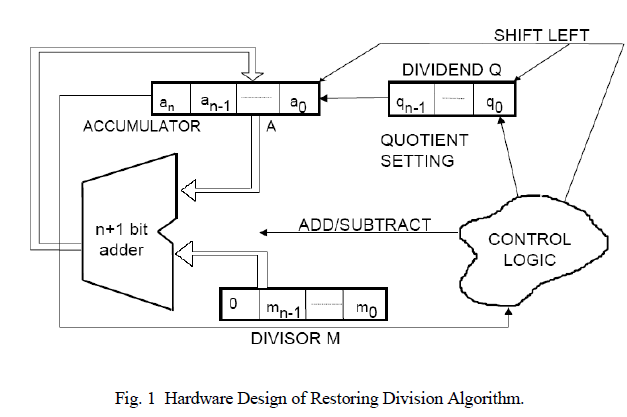 |
| Restoring division algorithm is very similar to manually performing long division. Algorithm for restoring division is mentioned below along with flowchart shown in Fig.2. |
| • Set Count to 0 and put 0 in A register. |
| • Start loop for n times |
| • Shift A & Q left one binary position |
| • Subtract M from a, placing the answer back in A |
| • if the sign of A < 0, set Q0 to 0 and add M back to A (restore A); |
| • otherwise, set q0 to 1 |
| • Check for count, when count = n-1 then stop the loop. |
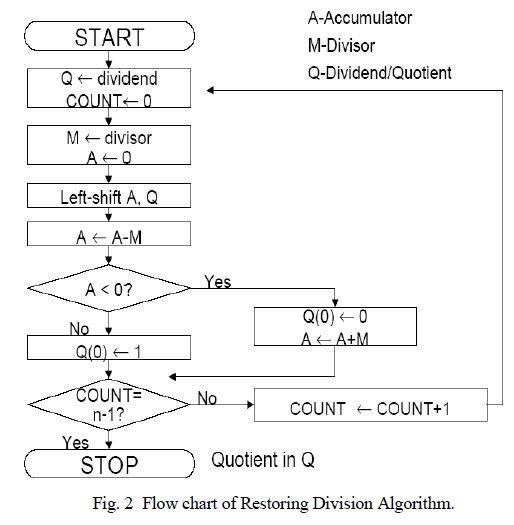 |
III.NON-RESTORING DIVISION |
| Non-restoring Division Algorithm (NrDA) comes from the restoring division. The restoring algorithm calculates the remainder by successively subtracting the shifted denominator from the numerator until the remainder is in the appropriate range. The operation in each step depends on the result of the previous step. Non-restoring division has a quotient digit set of { I, - I} instead of the conventional binary digit set [7,9]. By the non-restoring division approach, we find the -1 of the quotient bit can be simply set to 0, and the quotient is the actual quotient that we want to find [8]. We dismantle Q into bits. |
| Algorithm for restoring division is mentioned below along with flowchart shown in Fig.3. |
| 1. Subtract the divisor from the most significant bit (MSB) of the dividend. |
| 2. “Bring down” the next MSB of the divisor and append it to the result of step 1. |
| 3. Check the sign for the result of step 2. If the result of step 2 is positive: |
| a. Set the next MSB of the quotient to 1. |
| b. Subtract the divisor from the result to produce a new result. |
| If the result from step 2 is negative: |
| a. Set the next MSB of the quotient to 0. |
| b. Add the divisor to the result to produce a new result. |
| 4. Repeat steps 2 and 3 until all bits of the quotient are determined. |
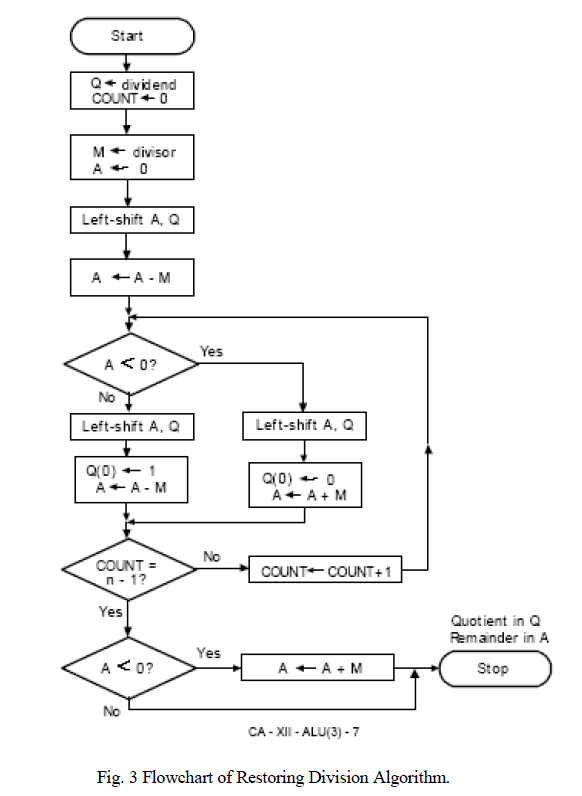 |
IV.HIGH SPEED ADDER/SUBTRACTOR |
| The addition of binary numbers in parallel implies that all the bits of the augends and the addend are available for computation at the same time. In a parallel adder, the carry output of each stage is connected to the carry input of the next higher order stage (ripple carry). Therefore, the sum and carry outputs of any stage can’t be produced until the input carry occurs. This leads to a time delay in the addition process. This delay is known as “carry propagation delay”. Since each bit of the sum output depends on the value of input carry, the value of “Si” in any given stage in the adder will be in its steady state final value only after the input carry to that stage has been propagated. The following methods are used to improve the speed of adders:- |
| 1. One method for reducing the carry propagation delay time is to employ faster gates with reduced delays. |
| 2. The most widely used technique employs the principle of “Look Ahead Carry”. This method utilizes logic gates to look at the lower-order bits of the augends and addend to see if a higher order carry is to be generated. It uses two functions: - Carry generate and Carry propagate. |
| The final carry will not depends on intermediate carry depends only on input bits.[10] |
| The carry-look ahead is a fast adder designed to minimize the delay caused by carry propagation in basic adders. It utilizes the fact that, at each bit position in the addition, it can be determined if a carry with be generated at that bit, or if a carry will be propagated through that bit. Logic diagram of full-adder with carry generation and carry propagation is shown in Fig.4. |
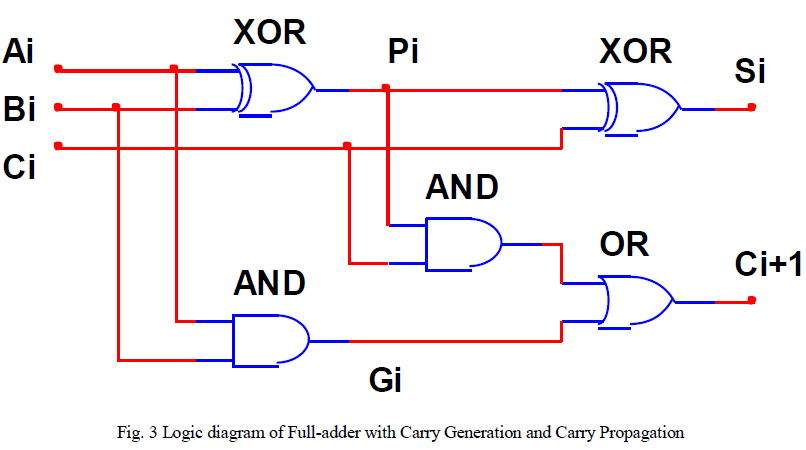 |
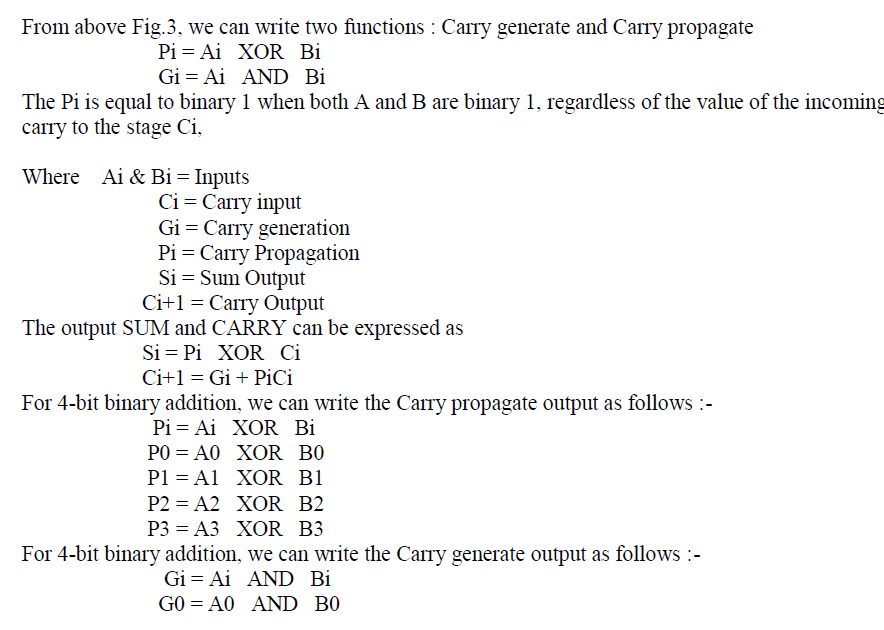 \ \ |
 |
| In above calculation, we can see that C1, C2, C3 & C4 are depends only on Co (Carry in), not on previous carry. There is not much difference between high speed adder and subtractor circuit. Only difference is 2nd input of the adder will inverted and then added using adder circuit. So we can use same circuit but with slightly modification as shown in Fig.5 diagram. |
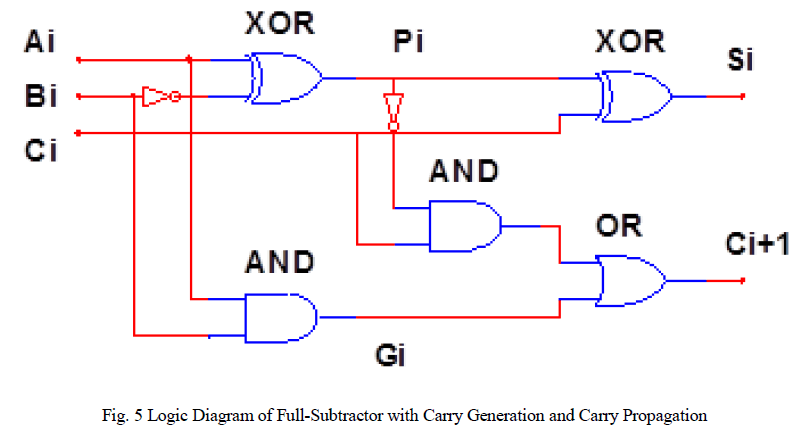 |
V.STEP BY STEP CALCULATION OF DIVISION OF 29 BY 11. |
| In this example we take 29 as dividend and store this value in register Dnd but in binary form, 9 as divisor and store its binary value in register D. We have taken two other registers AD and ZD for calculation and temporary storage of result as shown in Fig 6. |
INPUTS FOR DIVISION: |
| DND (Dividend) = 000011101 = (01DH) = (+29) |
| D (Divisor) = 000001011 = (00BH) = (+11) |
OUTPUTS FOR DIVISION: |
| Remainder (10 bits) = 0000000111= (007H) |
| Quotient (9 bits) = 000000011= (002H) |
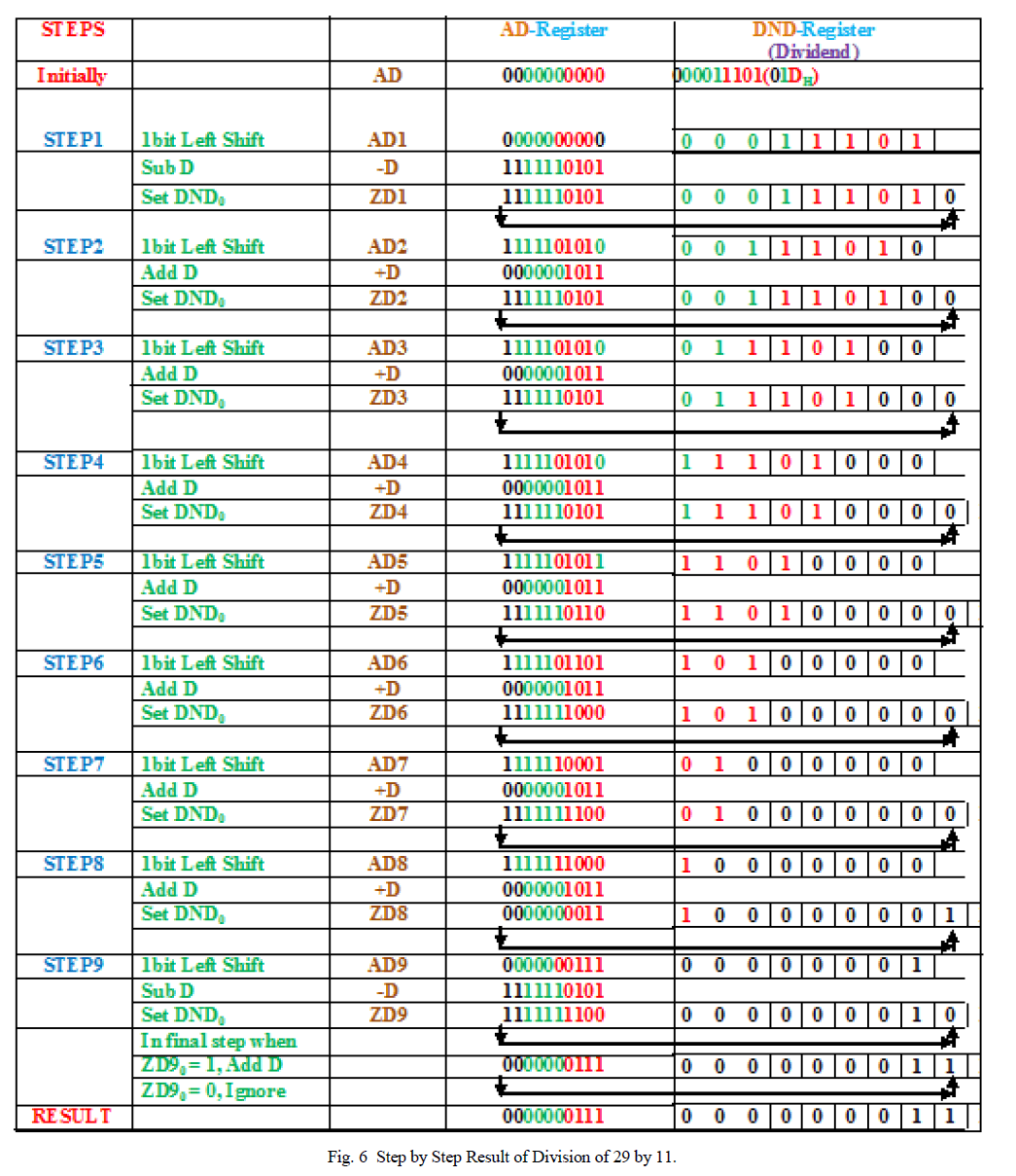 |
VI.SIMULATION RESULT |
| The entire architecture is modelled using VHDL. The coding is done on Xilinx ISE 8.1i on Spartan 3 using target device: XC3s100e-5vq100at speed grade of -5. Simulation can be done using ModelSim SE 6.3f simulator. The simulation result for DIV_HSA is shown on Fig. 7 and Fig.8 respectively. Fig. 7 shows the top RTL view of the division circuit. In this figure we can see that division hardware has two inputs and two outputs. Divisor is stored in register D and dividend is stored in register Dnd. Quotient and reminder of division algorithm is stored in register quotient and reminder register respectively. |
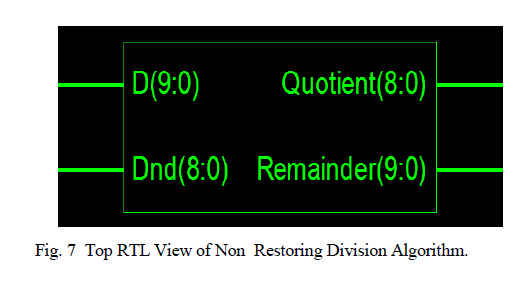 |
| Fig 8. Shows the final RTL view of the Division algorithm. in this diagram we can see that there are various block and that are performing various operation like calculation of partial division and calculation of remainder etc. |
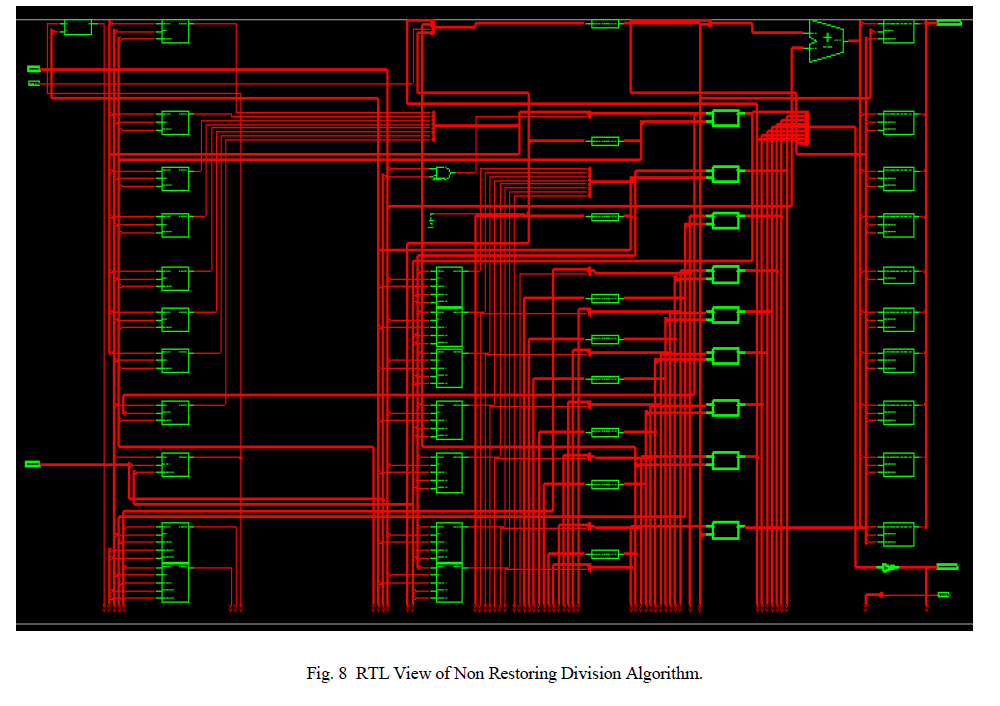 |
| Fig 9. Shows the simulation result of 29/11. We can see that 29 is stored in register Dnd which is dividend and 11 is stored in register D which is divisor. Both value are in decimal. After simulation of 29/11 quotient is stored in quotient and reminder is stored in reminder register this we can see in fig. 8. |
 |
 |
VII.CONCLUSION |
| Traditionally dividers have been avoided by DSP algorithm designers due to the complexity and cost of the hardware implementation. This paper presents that the non restoring division program is designed using VHDL and implemented on FPGA, which results the total utilization of Hardware as reflected in fig 10. It has been proved that its hardware implementation is not only easy but also cost effective. |
References |
|